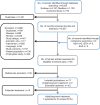Comparison of the Novel Oral Anticoagulants Apixaban, Dabigatran, Edoxaban, and Rivaroxaban in the Initial and Long-Term Treatment and Prevention of Venous Thromboembolism: Systematic Review and Network Meta-Analysis
- PMID: 26716830
- PMCID: PMC4696796
- DOI: 10.1371/journal.pone.0144856
Comparison of the Novel Oral Anticoagulants Apixaban, Dabigatran, Edoxaban, and Rivaroxaban in the Initial and Long-Term Treatment and Prevention of Venous Thromboembolism: Systematic Review and Network Meta-Analysis
Abstract
Background: Anticoagulation with low molecular weight heparin and vitamin K antagonists is the current standard of care (SOC) for venous thromboembolism (VTE) treatment and prevention. Although novel oral anti-coagulants (NOACs) have been compared with SOC in this indication, no head-to-head randomised controlled trials (RCTs) have directly compared NOACs. A systematic review and network meta-analysis (NMA) were conducted to compare the efficacy and safety of NOACs for the initial and long-term treatment of VTE.
Methods: Electronic databases (accessed July 2014) were systematically searched to identify RCTs evaluating apixaban, dabigatran, edoxaban, and rivaroxaban versus SOC. Eligible patients included adults with an objectively confirmed deep vein thrombosis (DVT), pulmonary embolism (PE) or both. A fixed-effect Bayesian NMA was conducted for outcomes of interest, and results were presented as relative risks (RR) and 95% credible intervals (Crl).
Results: Six Phase III RCTs met criteria for inclusion: apixaban (one RCT; n = 5,395); rivaroxaban (two RCTs; n = 3,423/4,832); dabigatran (two RCTs; n = 2,539/2,568); edoxaban (one RCT; n = 8,240). There were no statistically significant differences between the NOACs with regard to the risk of 'VTE and VTE-related death. Apixaban treatment was associated with the most favourable safety profile of the NOACs, showing a statistically significantly reduced risk of 'major or clinically relevant non-major (CRNM) bleed' compared with rivaroxaban (0.47 [0.36, 0.61]), dabigatran (0.69 [0.51, 0.94]), and edoxaban (0.54 [0.41, 0.69]). Dabigatran was also associated with a significantly lower risk of 'major or CRNM bleed' compared with rivaroxaban (0.68 [0.53, 0.87]) and edoxaban (0.77 [0.60, 0.99]).
Conclusions: Indirect comparisons showed statistically similar reductions in the risk of 'VTE or VTE-related death for all NOACs. In contrast, reductions in 'major or CRNM bleed' for initial/long-term treatment were significantly better with apixaban compared with all other NOACs, and with dabigatran compared with rivaroxaban and edoxaban. Results from the current analysis indicate that the NOACs offer clinical benefit over conventional therapy while highlighting relative differences in their bleeding profile.
Conflict of interest statement
Figures


References
-
- Heit JA, Mohr DN, Silverstein MD, Petterson TM, O'Fallon WM, Melton LJ 3rd. Predictors of recurrence after deep vein thrombosis and pulmonary embolism: a population-based cohort study. Archives of Internal Medicine. 2000;160(6):761–8. Epub 2000/03/29. . - PubMed
-
- Prandoni P, Noventa F, Ghirarduzzi A, Pengo V, Bernardi E, Pesavento R, et al. The risk of recurrent venous thromboembolism after discontinuing anticoagulation in patients with acute proximal deep vein thrombosis or pulmonary embolism. A prospective cohort study in 1,626 patients. Haematologica. 2007;92(2):199–205. . - PubMed
Publication types
MeSH terms
Substances
LinkOut - more resources
Full Text Sources
Other Literature Sources
Medical
Miscellaneous

